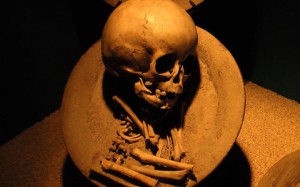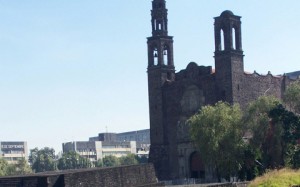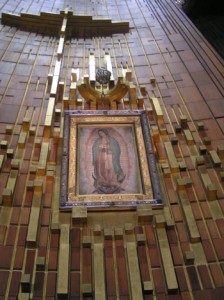Our Lady of Guadalupe — Come to Our Aid Again!
by Mark Armstrong | December 11, 2013 12:01 am
Tomorrow, hundreds of millions of people around the world will celebrate Masses to honor an appearance of the Blessed Mother made 482 year ago. On December 12, 1531, Our Lady of Guadalupe put an end to the Mayan culture of death. Mary was the woman, clothed in the sun, with the moon at her feet, who transformed the brutal culture of the Aztec/Mayan people. For thousands of years the evil of human sacrifices was practiced and perfected by the Aztecs and other Indian cultures throughout Mexico, Central and South America. That brutal culture of death was crushed with a simple miracle.
 [1]
[1]Sacrificed Baby
Photography © by Mark Armstrong
The prelude to this miracle came 11 years before, when, on Good Friday, April 22, 1519, the Spanish leader Hernán Cortés, accompanied by 11 ships, 473 men, 13 horses, and a small number of arms and cannons, landed in the Yucatan Peninsula in southeast Mexico. Cortés and his men had many motives for conquering these lands. Paramount among them was to end the practice of human sacrifice. There were gold and thrill seekers among the Spanish, but the brutal culture of death that demanded the killing of enemies, friends and family shocked Cortés and his battle hardened soldiers. In their very first encounter, the Aztecs believed that Cortés was their god Quetzalcoatl, returning as foretold hundreds of years before. The Aztecs attempted to appease Cortés and invited him to witness the slaughter firsthand. The Aztec emissaries served him powdered human blood hoping it would please him. When Cortés and his men watched the Aztecs cutting out and eating the hearts of their victims, dismembering them and pitching their body parts off the tops of stone pyramids and saw the crowds cheering below at the foot of these temples of death, Cortés was determined to put an end to human sacrifices.
No one will ever know exactly how many were humans were sacrificed over the course of thousands of years throughout what would become Mexico. By the late 1400’s, during the reign of the Aztecs, each community throughout Mexico was required to offer one thousand people each year to their god Huitlopchtli, the god of death, sun and war. The Aztecs had hundreds of gods that demanded human sacrifices each year. One Mexican historian estimated that one out of five children was sacrificed. Sometimes entire tribes were exterminated by sacrifice. Even the royalty offered members of their own families to be killed.
These sacrificial victims came down the long stone roads leading to the giant pyramids. Millions of victims either climbed, or were forcibly carried screaming, up the steep steps to the top of bloodstained stone platforms. The Aztec priests, dressed in satanic-looking dark costumes, would hold the victims’ arms and legs apart and then bend their bodies backwards over convex slabs of stones.
As the crowds cheered and the deadly drumbeat intensified, one of the priests would take a sharp blade of black volcanic glass and gut the victim open. As the blood sputtered out, the heart was still beating as it was held up for the crowd to see. Sharp stone blades would then cut off the victim’s head, arms and legs. The heart was eaten voraciously by the killers atop the pyramid as the rest of the body parts were hurled down the steps of the pyramids to the crowds below. Sometimes thousands were executed over the course of several days.
Cortés and his men — seasoned, hardened battle-tested soldiers — had never imagined that there could be such an advanced society living with so great an evil. It was beyond their comprehension. Some of the Spaniards, captured in the battles to come, became victims of the human sacrifice they were determined to eradicate. It took three years of warfare to conquer central Mexico and begin the end to this culture of death. There were many insurrections and attempts to return to the “old ways” and incidents of human sacrifices continued for nearly 10 year after official hostilities had ended.
Our Lady of Guadalupe and St. Juan Diego
Nearly 12 years after the Spanish landed and nine years after the end of hostilities, there had been only limited success with converting the Aztecs and other tribes to the Catholic faith. By 1531 there were few converts. The Spanish tried to translate, for the most part unsuccessfully, the tenets of the Faith to a people who did not have a written language. Suddenly, and quite unexpectedly for all involved, that all changed 482 years ago today when a convert to the faith, Juan Diego, encountered Mary, the Mother of God.
 [2]
[2]Church of Santiago de Tlatelolco
(where Juan Diego attended)
Juan Diego — his indigenous name, Cuauhtlatoatzin, means “the eagle that talks” — was a widowed convert to Roman Catholicism on his way to Mass on December 8, 1531, Mary’s Immaculate Conception feast day. For several years Juan Diego, then in his mid-fifties, got up before dawn and walked fifteen miles, one way, to attend Mass. The stone church he attended (which still stands in Mexico City) was erected from the dismantled Aztec pyramid stones. As Juan Diego walked passed by Tepeyac Hill, a few miles from church, the sky became bright and he heard singing on top of the hill, like the songs of various birds.
At the end of the song, as Juan Diego looked toward the hill, he heard a woman call out to him. There, he saw a young lady whose clothes shone with the radiance of the sun. He prostrated himself in front of her. When she asked Juan where he was going, he replied that he was going to church to hear the sermons of the friars. The woman identified herself as “the eternally consummate virgin Saint Mary, mother of the very true deity, God, the giver of life, the creator of people, the ever present, the Lord of heaven and earth.” She then asked Juan Diego to relate to the bishop her wish for a Church to be built on that very spot, where she would attend to the “weeping and sorrows of you and all the people of this land, and of the various peoples who love me….”
Juan Diego rushed the final miles on foot and waited for hours to see Bishop Juan Zumarraga. The friars were reluctant. After all, Juan Diego was a poor Indian with sandals, a walking stick and no appointment to see the bishop. After waiting patiently, Juan Diego was finally ushered in. When he related his story to Bishop Zumarraga, Juan Diego, through a translator, was told that he needed a sign to prove that this account was true. A series of other events happened to Juan Diego over the next three days that would take too long here to explain, but then on December 12, 1531, Mary provided a sign that convinced the bishop that Juan Diego spoke the truth.
When Mary appeared to Juan Diego 482 years ago today, she directed him to pick some flowers from the top of Tepeyac hill, and to gather them in his tilma (a long cloak) to present to the bishop as proof of her miraculous presence. (The roses he found only were previously known to grow in Spain, not in Mexico, and certainly not in the dead of winter.) Juan Diego did as he was asked and the Blessed Mother even helped him lay the flowers in his tilma.
When Juan Diego returned to the bishop and opened his cloak to show the roses, the bishop and all those present were amazed and fell prostrate. The image of Our Blessed Mother was emblazoned on the tilma.
 [3]
[3]Our Lady of Guadaupe
Photography © by Mark Armstrong
The image was far more than a mere picture of a beautiful lady. Her dress and manner told a story that all the Aztec Indians could understand. In one miraculous image, Mary explained her role in the Church and the way to God. This is how the image helped them to understand:
Her hands are folded in supplication; her posture indicating that she is interceding for us at the throne of the God. The luminous light surrounding the Lady is reminiscent of the “woman clothed with the sun” of Revelation 12:1. The rays of the sun would also be recognized by the Aztecs and other indigenous people as a symbol of their highest god, Huitzilopochtli. Thus, the lady comes forth hiding but not extinguishing the power of the sun. She is now going to announce the God who is greater than their sun god.
Mary is standing upon the moon. Again, the symbolism is that of the woman of Revelation 12:1 who has the “moon under her feet.” The moon for the Aztecs was the god of the night. By standing on the moon, she shows that she is more powerful than the god of darkness.
The eyes of Our Lady of Guadalupe are looking down with humility and compassion. This was a sign to the native people that she was not a god since in their iconography the gods stare straight ahead with their eyes wide open.
The angel supporting the Lady testifies to her royalty. To the Aztecs only kings, queens and other dignitaries would be carried on the shoulders of someone. The mantle of the Lady is blue-green or turquoise. To the native people, this was the color of the gods and of royalty. The stars on Mary’s mantle show that she comes from heaven.
The gold-encircled cross brooch under the neck of the Lady’s robe is a symbol of sanctity. The girdle or bow around her waist is a sign of her virginity, but it also has several other meanings. The bow appears as a four-petaled flower. To the native Indians this was the nahui ollin, the flower of the sun, a symbol of plenitude. For them, this was the symbol of creation and new life. The high position of the bow and the slight swelling of the abdomen show that the Lady is with child.
By Mary’s dress, the image shows that she is of royalty from heaven and was both a virgin and “with child.” Thus, the image of Our Lady of Guadalupe, the patroness of the Americas, has become a powerful symbol for the pro-life movement.
Culture of Death Today
Our culture, in which Satan has convinced many of our people that slaughtering their most innocent citizens in their mother’s wombs is a basic human right, needs another wake-up call.
In the Aztec society the brightest, most well-trained leaders and the entire culture were convinced of the need to kill innocent people atop those pyramids for thousands of years. Today in America some of the brightest, best-trained leaders have passed laws that allow for the murder of our most innocent. Today in our culture you have 50-50 chance to be slaughtered once you have been conceived. Once you are killed your body parts are farmed out to be used for everything from cosmetics to biomedical experiments or your DNA can serve as the growing agent for childhood vaccines. Our society uses and depends on the slaughter of tens of millions of innocent human beings. It cannot survive that way.
Jesus sent his Mother once to triumph over the serpent-god that the Aztecs, Mayans and other Indians were worshipping and to put an end to the brutal human sacrifice that was being practiced. Mary ended that Aztec culture of death once and for all. We can surely trust that Our Lady will intervene for us and overwhelm the darkness with the brightness of her presence once again. On this Feast of Our Lady of Guadalupe, let us pray for her intervention to bring an end to the deadly errors in our society. Hail Mary, full of grace! Pray today that Mary, the protector of the Americas and the unborn will help defeat the modern culture of death.
If you liked this article, please share it with your friends and family using the Share and Recommend buttons below and via email. We value your comments and encourage you to leave your thoughts below. Thank you! – The Editors
- [Image]: http://www.integratedcatholiclife.org/wp-content/uploads/aztec-baby-sacrificed-featured-w480x300-mark.jpg
- [Image]: http://www.integratedcatholiclife.org/wp-content/uploads/church-of-santiago-featured-w480x300-mark.jpg
- [Image]: http://www.integratedcatholiclife.org/wp-content/uploads/our-lady-of-guadalupe-w350-mark.jpg
Source URL: https://integratedcatholiclife.org/2013/12/mark-armstrong-lady-of-guadalupe-come-to-our-aid/